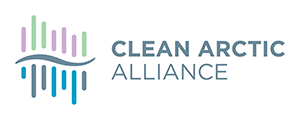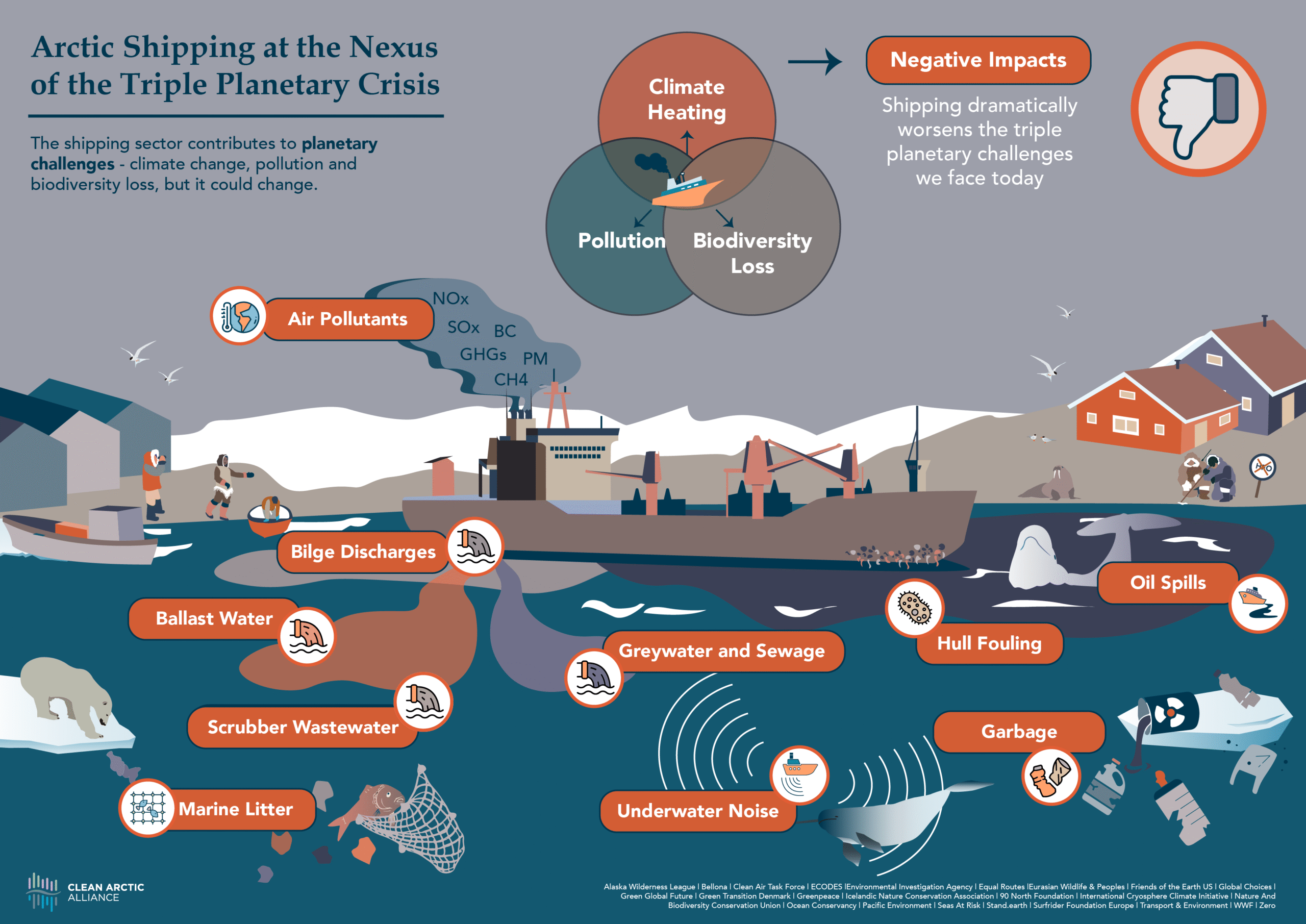
29 October, 2024: – On the eve of a session of the Nordic Council in Reykjavik, which is set to consider of proposals regarding the threat of climate change in the Arctic, regulations on polar fuels, and the need for cooperation on sustainability in the Nordic region, Nordic Ministers must respond to pressure from their own parliamentarians by addressing shipping’s impact on the Arctic.
Today, the Nordic Council’s Committee for a Sustainable Nordic Region made a decision to proceed with a proposal on polar fuels which means that further investigation and negotiation will take place with a view to seeking a resolution to be adopted at a forthcoming Nordic Council session. The Clean Arctic Alliance is calling for Nordic Ministers to act now to reduce pollution from shipping – highlighting in particular the urgent need to reduce emissions of black carbon, a short-lived climate pollutant with a disproportionate impact on Arctic snow and ice.
“Last week, in an open letter to the Nordic Council of Ministers, over 40 climate scientists confirmed that the Arctic region is ‘ground zero’ for tipping point risks and climate regulation across the planet”, said Dr Sian Prior, Lead Advisor to the Clean Arctic Alliance. “The scientists are calling for Arctic tipping point risks to be taken seriously in governance and policy and called for steps to be taken to minimise the risks, including greater urgency in the global effort to reduce emissions as quickly as possible, in order to stay close to the 1.5 degree Celsius limit set by the Paris Agreement.”
“This week a decision to proceed with a proposal on polar fuels is very welcome, and the Nordic Council also has an opportunity to agree to urgent action to reduce emissions of black carbon from shipping in the Arctic”, continued Prior. “ Unregulated black carbon emissions from shipping in northern latitudes are currently increasing and the soot that is released warms the atmosphere, while also speeds up the melting when it settles onto snow and ice.”
“The Clean Arctic Alliance is calling on Nordic governments to take the first steps and agree to work within the International Maritime Organization (IMO) and work for stronger rules of marine pollution including supporting the concept of polar fuels – ships’ fuels which result in lower emissions of black carbon or soot”, said Prior. “It is also necessary to support the development of international mandatory regulation through the IMO’s International Convention for the Prevention of Pollution from Ships (MARPOL) which would require international shipping operating in the Arctic to only use polar fuels in this vulnerable region. Furthermore, the Clean Arctic Alliance is calling on the Nordic Council and Nordic Ministers to take domestic action and require ships operating in their own waters to only do so using cleaner fuels such as distillate fuels.”
In parallel this week, as the Arctic Council’s Expert Group on Black Carbon and Methane (EGBCM) is set to consider a path forward on developing and setting new 2035 black carbon reduction targets, the Clean Arctic Alliance is calling on Arctic countries to agree to a new clear and ambitious target to reduce black carbon emissions impacting the Arctic from all sources.
“With shipping on the rise in the Arctic and black carbon emissions following the same trajectory, an ambitious 2035 target must be set by the Arctic Council for reducing the impact of black carbon emissions in the Arctic and that must include shipping”, said Andrew Dumbrille, North America Strategic and Technical Advisor to the Clean Arctic Alliance. “A full 20% of shipping’s global climate impact comes from black carbon, with over two-thirds of the total Arctic black carbon from ships coming from vessels operating in the Arctic but outside the Polar Code boundary.”
“The Clean Arctic Alliance is calling on the Arctic Council to put in place specific black carbon reductions for Arctic shipping, for example 75% by 2030 and 95% by 2035 applying to a geographic area larger than the Polar Code such as the Arctic Human Development Report (AHDR) boundary, to account for substantial Arctic emissions of BC outside the Polar Code region”, added Dumbrille.
About Black Carbon and the Arctic
Black carbon is a short-lived climate pollutant, produced by the incomplete burning of fossil fuels, with an impact more than three thousand times that of CO2 over a 20 year period. It makes up around one-fifth of international shipping’s climate impact. Not only does it contribute to warming while in the atmosphere, black carbon accelerates melting if deposited onto snow and ice – hence it has a disproportionate impact when released in and near to the Arctic.
The melting snow and ice exposes darker areas of land and water and these dark patches then absorb further heat from the sun and the reflective capacity of the planet’s polar ice caps is severely reduced. More heat in the polar systems – results in increased melting. This is the loss of the albedo effect.
Declines in sea ice extent and volume are leading to a burgeoning social and environmental crisis in the Arctic, while cascading changes are impacting global climate and ocean circulation. Scientists have high confidence that processes are nearing points beyond which rapid and irreversible changes on the scale of multiple human generations are possible. Scientists say it is now too late to save summer Arctic sea ice, and research has shown that “preparations need to be made for the increased extreme weather across the northern hemisphere that is likely to occur as a result.”
Black carbon also has a negative impact on human health, and recent research has found black carbon particles in the body tissues of foetuses, following inhalation by pregnant mothers.
The need to reduce emissions of black carbon because of both the climate and health impacts has been long recognised. On land, considerable effort has been made to ban dirtier fuels in power stations, to install diesel particulate filters on land-based transport, and to improve the burning of dry wood – all to reduce emissions of black carbon and improve air quality. However, at sea the same efforts have not yet been made.
In a paper submitted to a recent meeting of the IMO’s Marine Environment Protection Committee (MEPC 82/5/2*: Regulating Black Carbon emissions from international shipping impacting the Arctic) NGOs called on IMO Member States to consider the development of a new regulation for inclusion in MARPOL Annex VI (the main international treaty addressing air pollution prevention requirements from ships) which would identify suitable polar fuels, for example distillate fuels, such DMA or DMZ, to deliver an immediate fuel-based reduction in black carbon emissions from international shipping impacting the Arctic. The paper develops the concept of “polar fuels” discussed at technical subcommittee meeting (PPR 11) and sets out the fuel characteristics that would distinguish polar fuels from residual fuels and thus lead to fuel-based reductions in ship Black Carbon emissions if mandated for use in and near the Arctic. The concept of polar fuels will be discussed further at the next meeting of the PPR technical subcommittee in January 2025.
- Find out more about black carbon
- Briefing: Only Polar Fuels should be used in the Arctic (north of 60°N)
- Editorial: The IMO Says It Will Act on Arctic Black Carbon Emissions From Ships – So What Happens Next?
- Press release, October 4th 2024: IMO Sets Clear Pathway for Future Black Carbon Regulation for Shipping
- Infographic: How to regulate and control black carbon emissions from shipping
ENDS
Contact:
Dave Walsh, Communications Advisor, [email protected], +34 691 826 764
About the Clean Arctic Alliance
Made up of 23 not-for-profit organisations, the Clean Arctic Alliance campaigns to persuade governments to take action to protect the Arctic, its wildlife and its people.
Members include: Alaska Wilderness League, Bellona, Clean Air Task Force, Ecology and Development Foundation ECODES, Environmental Investigation Agency, Equal Routes, Eurasian Wildlife and Peoples, Friends of the Earth US, Global Choices, Green Global Future, Green Transition Denmark, Greenpeace, Iceland Nature Conservation Association, International Cryosphere Climate Initiative, Nature And Biodiversity Conservation Union, Ocean Conservancy, Pacific Environment, Seas At Risk, Surfrider Foundation Europe, Stand.Earth, Transport & Environment, WWF and Zero.
More more information visit https://www.cleanarctic.org/



